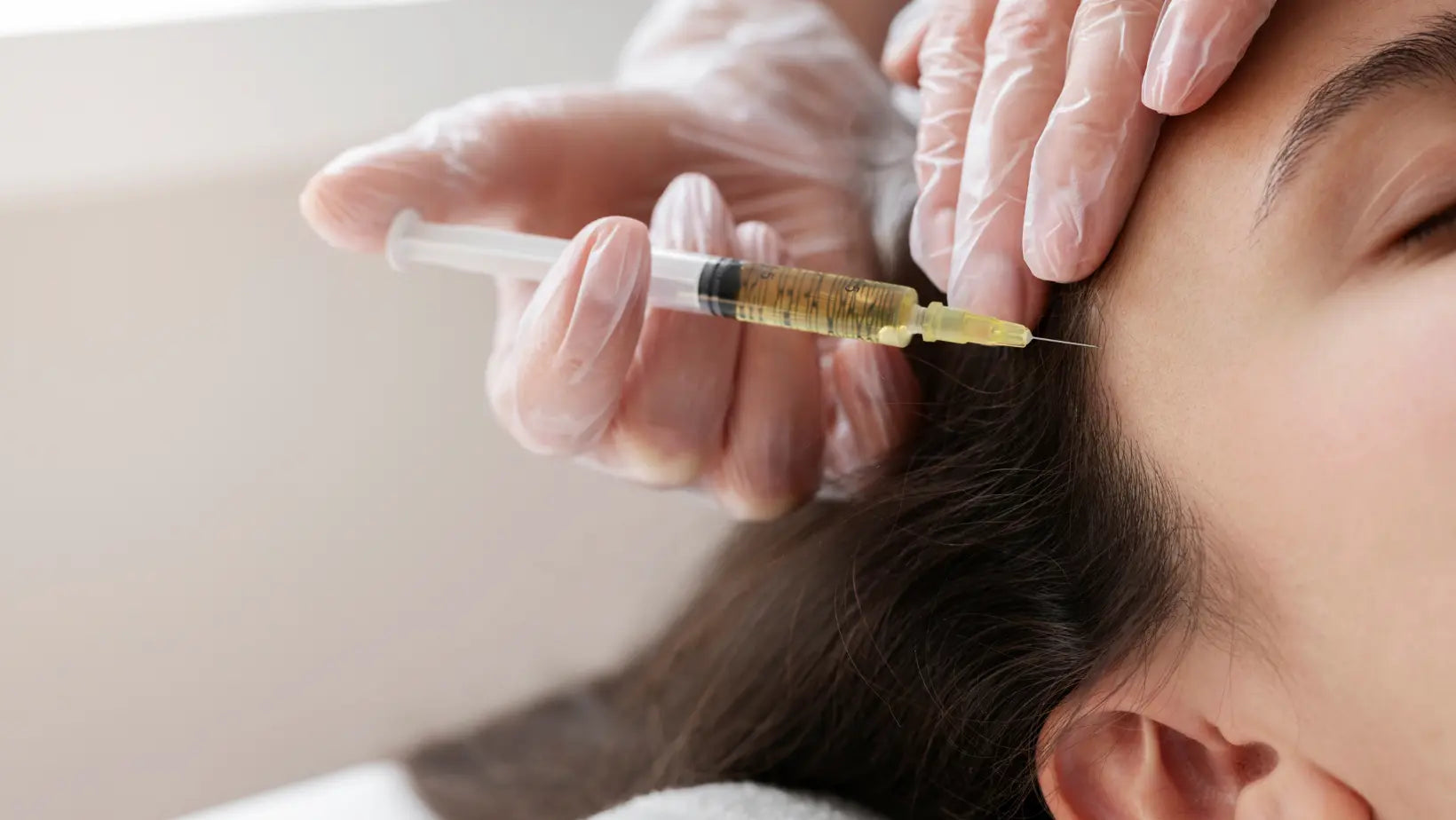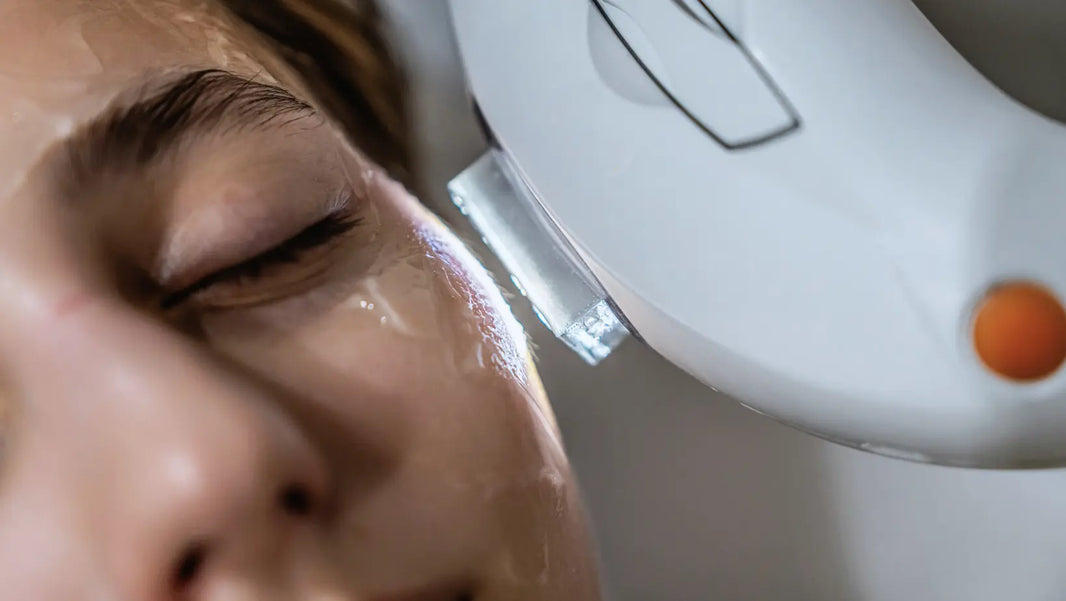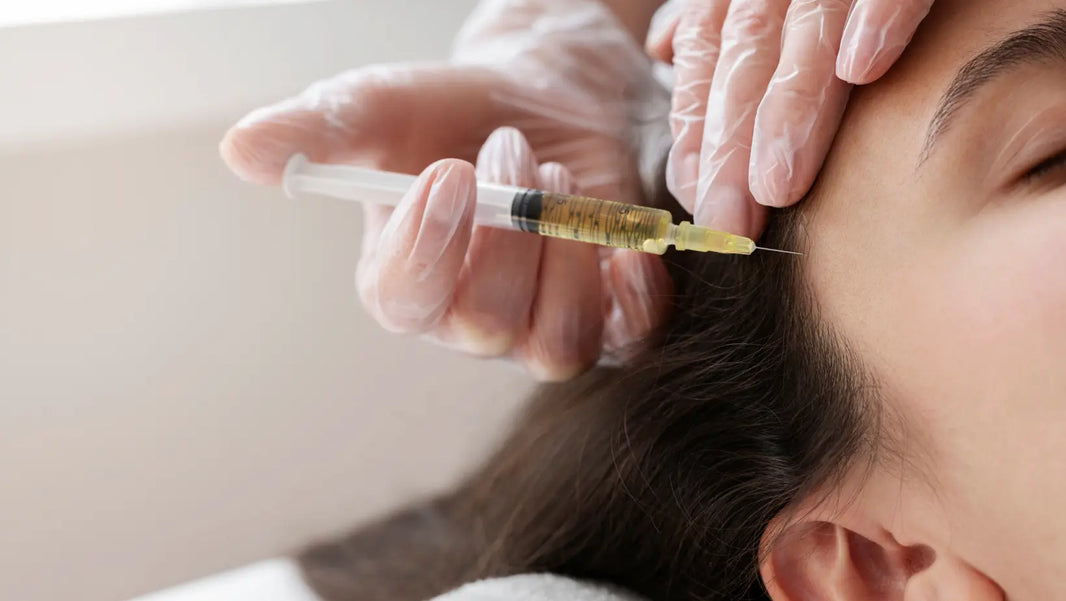If you're seeking next-level skin rejuvenation, multiple cutting-edge approaches are commanding attention in aesthetic dermatology. This comprehensive guide examines microneedling combined with exosomes compared to platelet-rich plasma (PRP) and other regenerative treatments. By exploring clinical evidence, mechanisms of action, side effects, and specific applications, you'll gain the knowledge needed to make informed decisions about your aesthetic journey.
Understanding Microneedling: The Foundation
Microneedling, also called collagen induction therapy, uses fine needles to create controlled micro-injuries in the skin's surface. These micro-channels stimulate the wound-healing cascade, triggering increased collagen and elastin production, improved skin texture, reduced scarring, and overall renewal. The procedure addresses acne scars, fine lines, wrinkles, enlarged pores, uneven tone, and post-inflammatory changes.
The transformative results occur when combining microneedling with regenerative adjuncts like exosomes, PRP, and newer biologics. Each combination offers unique benefits and limitations that we'll explore comprehensively.
Microneedling with Exosomes vs PRP
Understanding Exosomes
Exosomes are nano-sized extracellular vesicles containing lipids, proteins, RNA, and signaling molecules that mediate cell-to-cell communication. Unlike PRP which primarily delivers growth factors, exosomes carry complex cargo that can modulate multiple cellular pathways simultaneously including anti-inflammatory, anti-pigmentation, and regenerative responses.
Human adipose-derived stem cell exosomes combined with microneedling demonstrated significant improvements in hydration, elasticity, and pigmentation in a 12-week split-face study1. Source quality matters immensely, as exosomes can derive from mesenchymal stem cells, adipose tissue, keratinocytes, or plant sources, each with varying therapeutic profiles.
Understanding PRP
Platelet-rich plasma is autologous blood processed to concentrate platelets that release growth factors including PDGF, TGF-β, and VEGF. When activated, these factors promote fibroblast proliferation, collagen synthesis, and angiogenesis. PRP has over a decade of clinical use with established safety profiles.
Evidence for PRP combined with microneedling is mixed. For acne scars, studies2 show 62% improvement versus 45% with microneedling alone. However, for aging skin, randomized trials found no significant advantage of PRP over saline when combined with microneedling, highlighting the importance of matching treatment to indication.
Direct Comparison: Mechanisms and Outcomes
|
Factor |
Exosomes |
PRP |
|
Mechanism |
Nano-vesicles with complex signaling molecules |
Growth factors from concentrated platelets |
|
Evidence Level |
Emerging (promising small studies) |
Established (mixed results) |
|
Sessions Needed |
1-2 typically |
3-6 typically |
|
Results Timeline |
2-4 weeks visible, 6-8 weeks full |
4-6 weeks visible, 3-4 months full |
|
Cost |
Higher per session |
Moderate per session |
The fundamental difference: exosomes offer broader pathway modulation while PRP provides concentrated growth factor delivery. Neither is definitively superior - effectiveness depends on indication, patient factors, and treatment goals.
Microneedling with Exosomes vs PRP Side Effects
Exosome Side Effects and Safety Profile
Early clinical reports indicate exosomes are generally safe in small cohorts with no major adverse events reported up to 22 weeks in limited studies. Common mild side effects include temporary redness, minor swelling, and skin sensitivity lasting 24-48 hours. Since exosomes are not autologous, theoretical concerns exist regarding immunogenic reactions, though clinical reports remain minimal.
Critical safety considerations for exosomes:
- Source traceability and product quality verification essential
- Risk of contamination if sterility protocols inadequate
- Limited long-term safety data beyond 6 months
- Regulatory oversight varies by jurisdiction
- Potential unanticipated effects in compromised skin or with malignancy risk
PRP Side Effects and Safety Profile
PRP enjoys a well-established safety profile with over a decade of clinical use. Because it's autologous, immunogenic and allergic reactions are exceedingly rare. Common side effects include mild redness lasting 1-3 days, temporary swelling, minor bruising at injection sites, and transient tenderness. These typically resolve within 4-5 days without intervention.
PRP safety advantages:
- Autologous nature eliminates transmission disease risk
- Minimal risk of adverse reactions or rejection
- Extensive safety data across multiple applications
- Regulatory approval in many jurisdictions

Exosomes vs PRP for Face
Facial Rejuvenation Mechanisms
For comprehensive facial rejuvenation, both modalities target collagen production, skin texture, tone evenness, and fine line reduction. Exosomes excel at multi-pathway modulation, potentially addressing pigmentation, inflammation, and regeneration simultaneously. A 12-week split-face study3 showed significant improvements in hydration, elasticity, and pigmentation with exosomes compared to microneedling alone.
PRP demonstrates mixed results for facial aging. While some patients report satisfaction with improved skin quality, objective measurements in aging skin show variable outcomes. One randomized trial4 found no significant improvement in skin laxity or rhytides with PRP versus saline over 24 weeks. However, PRP combined with microneedling shows consistent effectiveness for acne scarring with 62% improvement rates.
Best Face Applications by Treatment
Exosomes optimal for:
- Overall skin quality and texture improvement
- Pigmentation irregularities and melasma
- Inflammatory skin conditions
- Pore size reduction and skin tone evening
PRP optimal for:
- Atrophic acne scars and textural scars
- Volume restoration in specific areas
- Established protocols with predictable outcomes
- Cost-conscious patients preferring autologous treatments
PRP and Exosomes for Hair Loss
PRP for Androgenetic Alopecia
PRP injection for androgenetic alopecia has substantial evidence with multiple meta-analyses demonstrating efficacy. Studies show significant increases in hair density from 141.9 to 177.5 hairs per square centimeter following treatment. The mechanism involves growth factors stimulating hair follicle proliferation and extending anagen phase duration.
Microneedling combined with PRP for hair restoration shows promise but remains less studied than PRP injection alone. Limited data suggests the combination may enhance results, with one study showing 24.5% increase in hair count versus 17.9% with PRP alone. However, evidence remains preliminary with small sample sizes and variable protocols.
Exosomes for Hair Restoration
Adipose-derived stem cell exosomes show encouraging preclinical results for hair regeneration by activating Wnt and beta-catenin pathways essential for hair follicle cycling. Early clinical trials suggest exosomes may promote hair growth, though data remain limited compared to PRP's established evidence base.
Microneedling with topical exosome application for alopecia represents an emerging area with insufficient clinical data for definitive recommendations. The theoretical advantage lies in exosomes' ability to modulate multiple regenerative pathways simultaneously, but robust comparative trials are needed.
Hair Loss Treatment Recommendations
For hair loss treatment, PRP injection currently offers the most substantial evidence base and established protocols. Exosomes represent an exciting frontier but require more clinical validation. Patients seeking hair restoration should prioritize PRP unless participating in clinical trials or working with providers experienced in exosome therapy who can ensure product quality and appropriate protocols.
Exosomes vs PRP for Under Eyes
PRP for Periorbital Rejuvenation
PRP demonstrates particular effectiveness for periorbital dark circles and wrinkles. A clinical trial with 30 participants showed 60.9% achieving moderate to excellent improvement in dark circles and 78.3% improvement in periorbital wrinkles at 6-month follow-up. The treatment was statistically significant for dark circle reduction.
However, results remain variable across studies. Some research shows only modest improvements with significant patient-to-provider perception discrepancies. The delicate under-eye area requires precise technique and appropriate platelet concentration for optimal outcomes. Multiple sessions typically needed with maintenance treatments every 6-12 months.
Exosomes for Under-Eye Treatment
Exosomes offer theoretical advantages for the periorbital region through anti-inflammatory and pigmentation-modulating properties. The nano-vesicles may address multiple contributing factors to dark circles including vascular congestion, pigmentation, and skin thinning. However, specific clinical data for under-eye exosome applications remains limited.
Early reports suggest exosomes may improve skin texture and reduce inflammation in the periorbital area with potentially fewer treatments than PRP. The lack of blood product may appeal to needle-averse patients. However, providers must ensure exosome quality and appropriate application techniques for this sensitive area.
Under-Eye Treatment Selection
For under-eye concerns, PRP currently offers more robust clinical evidence, particularly for dark circles and fine lines. Exosomes may be considered for patients seeking alternatives to blood products or those with inflammatory components to their periorbital concerns. Realistic expectations and multiple treatment sessions should be anticipated with either approach.
Microneedling with Exosomes vs PRF
Platelet-rich fibrin (PRF) represents an evolution of PRP technology, prepared without anticoagulants and yielding a fibrin matrix with sustained growth factor release. PRF contains platelets, leukocytes, and fibrin scaffold in physiologic concentrations. The slower centrifugation preserves more growth factors and creates autologous fibrin mesh.
Compared to exosomes, PRF offers prolonged growth factor release over 7-14 days versus PRP's more immediate but shorter-duration effect. The fibrin matrix provides structural support potentially enhancing tissue regeneration. PRF remains autologous, eliminating immunogenic concerns while exosomes offer broader pathway modulation.
Limited direct comparative data exists between microneedling with PRF versus exosomes. PRF may excel for volumetric correction and sustained regeneration, while exosomes potentially offer faster visible results and anti-inflammatory benefits. Both represent advanced biologics with specific advantages depending on treatment goals.
Microneedling with Exosomes vs Without
Microneedling alone produces measurable improvements through collagen induction and wound healing responses. Studies demonstrate 31-62% improvement in various skin conditions with standalone microneedling. The mechanical injury triggers growth factor release, stem cell activation, and neocollagenesis.
Adding exosomes to microneedling enhances outcomes through synergistic mechanisms. The 12-week split-face study showed microneedling with exosomes significantly outperformed microneedling alone for hydration, elasticity, and pigmentation. The improvement became statistically significant at week 6 and continued improving through week 12.
The added value of exosomes justifies the increased cost for patients seeking optimal results, particularly for complex concerns involving pigmentation, inflammation, or poor healing response. However, standalone microneedling remains effective and cost-efficient for straightforward texture and mild scar concerns.
Microneedling with Exosomes vs PDGF
Platelet-derived growth factor (PDGF) represents a single purified growth factor involved in wound healing and tissue regeneration. PDGF stimulates fibroblast proliferation, collagen synthesis, and angiogenesis through specific receptor binding. It's one component among many in PRP and a signaling molecule potentially present in exosome cargo.
Exosomes offer advantage over isolated PDGF through comprehensive signaling molecule delivery including multiple growth factors, microRNAs, and regulatory proteins. This mimics natural cellular communication more closely than single-factor supplementation. Exosomes provide balanced, physiologic signaling rather than supraphysiologic single-factor stimulation.
While PDGF demonstrates efficacy in wound healing applications, its use in aesthetic microneedling remains limited. Exosomes' multi-component nature likely offers superior outcomes for skin rejuvenation through simultaneous modulation of multiple regenerative pathways. Clinical comparative data remains limited, however.
Microneedling with Exosomes vs PDRN
Polydeoxyribonucleotide (PDRN) is a tissue repair activator derived from salmon sperm DNA that promotes wound healing, angiogenesis, and anti-inflammatory effects through adenosine A2A receptor activation. PDRN demonstrates clinical effectiveness for skin rejuvenation with a growing evidence base in Asian markets.
A recent comparative study showed microneedling with PDRN demonstrated more significant wrinkle reduction compared to microneedling with PRP, though both treatments proved effective for mild to moderate wrinkles and hyperpigmentation. PDRN's mechanism differs from exosomes, working primarily through adenosine receptor pathways.
Exosomes and PDRN represent different approaches to regenerative aesthetics. PDRN offers established protocols with predictable outcomes and lower cost than exosomes. Exosomes provide broader pathway modulation with potentially faster visible results. Direct head-to-head comparison studies are needed to determine superiority for specific indications.
Microneedling with Exosomes vs Rejuran
Rejuran is a branded PDRN product from South Korea specifically formulated for skin rejuvenation. It contains purified polynucleotides that activate tissue repair mechanisms, improve skin elasticity, and reduce inflammation. Rejuran has gained popularity in Asian aesthetic markets with growing adoption globally.
When combined with microneedling, Rejuran demonstrates effectiveness for skin texture, fine lines, and overall skin quality improvement. The treatment typically requires 3-4 sessions with maintenance every 6-9 months. Side effects remain minimal with brief redness and mild swelling resolving within 24-48 hours.
Comparing exosomes to Rejuran involves weighing established protocols against emerging technology. Rejuran offers proven effectiveness at moderate cost with predictable outcomes. Exosomes potentially provide more comprehensive pathway modulation with faster results but at higher cost and with less long-term data. Patient preference, budget, and specific concerns guide selection.
Microneedling with Exosomes vs Sculptra
Sculptra (poly-L-lactic acid) is an injectable biostimulator that stimulates gradual collagen production over months. Unlike exosomes which provide biological signaling molecules, Sculptra works through foreign body response triggering fibroblast activation and neocollagenesis. Results develop slowly over 3-6 months with durability exceeding 2 years.
Combining microneedling with topical Sculptra represents off-label use with limited evidence. Traditional Sculptra injection targets deep dermis and subcutaneous tissue for volumetric correction. Microneedling primarily affects papillary dermis, creating different treatment planes. The combination lacks robust clinical validation.
Exosomes with microneedling and injectable Sculptra serve different aesthetic goals. Exosomes address surface-level concerns including texture, tone, and pigmentation with relatively quick results. Sculptra provides deep volumetric correction with long-lasting but slowly developing effects. Many patients benefit from sequential or combination treatments rather than choosing one over the other.
Microneedling with Exosomes vs Salmon Sperm
Salmon sperm DNA extract, marketed under various names including PDRN and polynucleotide preparations, contains purified DNA fragments that activate adenosine receptors promoting tissue repair. The source material undergoes extensive purification to remove proteins and contaminants, yielding bioactive polynucleotide chains.
Clinical studies demonstrate salmon DNA preparations improve skin hydration, elasticity, and wrinkle appearance when used with microneedling. The mechanism involves stimulating fibroblast activity, promoting angiogenesis, and providing anti-inflammatory effects. Treatment protocols typically involve 3-4 sessions with maintenance every 6 months.
Comparing exosomes to salmon DNA preparations highlights different biological approaches. Salmon DNA works primarily through single-pathway adenosine receptor activation, while exosomes provide multi-pathway modulation. Cost considerations favor salmon DNA preparations, while exosomes potentially offer broader anti-aging effects. Clinical data directly comparing these modalities remains limited.
Microneedling with Exosomes vs RF Microneedling
Radiofrequency (RF) microneedling combines traditional microneedling with thermal energy delivered through needle electrodes. The RF energy heats dermis causing collagen contraction and neocollagenesis while microneedles create channels for deeper energy penetration. RF microneedling excels for skin tightening, texture improvement, and treating laxity.
This comparison involves technology versus biology rather than direct alternatives. RF microneedling can be combined with exosome application, potentially offering synergistic benefits. The RF creates thermal injury stimulating regeneration while exosomes provide biological signaling molecules to enhance healing and modulate inflammation.
For patients, the decision involves energy-based versus biologic-based regeneration or combining both. RF microneedling alone costs less than adding exosomes but may provide insufficient results for complex concerns involving pigmentation or inflammation. Sequential treatments—RF microneedling followed by exosome application—represent an emerging protocol showing promise in early clinical experience.
Making Your Treatment Decision
Selecting the Right Approach
Treatment selection depends on multiple factors including primary concerns, budget, tolerance for novel therapies, and provider expertise. Exosomes suit patients seeking comprehensive rejuvenation with pigmentation or inflammatory components who accept higher costs for potentially faster results. PRP remains ideal for established protocols, cost consciousness, and scar treatment.
Alternative biologics like PDRN, Rejuran, and PRF offer middle-ground options with moderate costs and growing evidence bases. RF microneedling provides energy-based alternatives for laxity and tightening concerns. Many patients ultimately benefit from customized combination protocols addressing multiple skin concerns simultaneously.
Provider Selection and Quality Assurance
Critical considerations:
- Verify provider credentials and experience with specific treatments
- Request product sourcing documentation for exosomes and biologics
- Ensure sterility protocols and facility accreditation
- Discuss realistic expectations and treatment timelines
- Obtain detailed cost breakdown including all treatment components
Aftercare Essentials
Regardless of chosen treatment, proper aftercare maximizes results and minimizes complications. Keep treated areas clean and protected, avoid makeup for 24 hours minimum, use gentle non-irritating skincare with sun protection, avoid sun exposure and tanning for 2-3 weeks, skip strenuous exercise for 24-48 hours, and monitor for unusual redness, pain, or discharge suggesting infection.
Advanced biologics like exosomes require particularly careful post-treatment protocols. Follow provider instructions precisely, attend all follow-up appointments for assessment, document progress with photographs, and communicate any concerns promptly to your treatment team.
Conclusion: Your Personalized Path Forward
The landscape of regenerative aesthetic treatments continues expanding with exosomes, PRP, PRF, PDRN, and other biologics offering distinct advantages. No single treatment reigns supreme across all applications. Success requires matching treatment modality to specific concerns, patient factors, and realistic expectations.
Exosomes represent exciting innovation with growing evidence for comprehensive rejuvenation. PRP offers established reliability particularly for scarring. Alternative biologics provide middle-ground options balancing innovation and evidence. RF microneedling adds energy-based enhancement possibilities.
Your aesthetic journey succeeds through informed decision-making, realistic expectations, and partnership with qualified providers prioritizing safety and efficacy equally. Research thoroughly, ask detailed questions, verify product quality, and choose practitioners with appropriate expertise in your selected treatment modality.
The future promises continued refinement of protocols, larger comparative trials, and better understanding of optimal treatment combinations. Until then, approach regenerative aesthetics as personalized medicine requiring individualized assessment, careful provider selection, and commitment to proper protocols including pre-treatment preparation and post-treatment care.
Here's a concise FAQ section optimized for Google FAQ schema:
FAQ
Which is better PRP or exosomes?
Neither is universally "better"—effectiveness depends on your concern. Exosomes excel for comprehensive facial rejuvenation, showing significant improvements in hydration, elasticity, and pigmentation in clinical studies. PRP proves highly effective for acne scars (62% improvement vs 45% with microneedling alone) but shows mixed results for aging skin. Exosomes offer multi-pathway modulation and faster visible results (2-4 weeks), while PRP provides established safety with lower cost per session but requires more treatments (3-6 vs 1-2).
Are exosomes worth it with microneedling?
Yes, for optimal results. A 12-week split-face study demonstrated microneedling with exosomes significantly outperformed microneedling alone for hydration, elasticity, and pigmentation, with improvements becoming statistically significant at week 6. The combination enhances outcomes through synergistic mechanisms—microneedling creates channels while exosomes deliver complex signaling molecules. However, standalone microneedling remains effective and cost-efficient for straightforward texture concerns and mild scarring.
What is the dark side of exosomes?
Key concerns include lack of FDA regulation, inconsistent product quality, high cost ($800-2000+ per session), limited long-term safety data, and potential contamination risks. Source matters immensely—exosomes from mesenchymal stem cells, adipose tissue, or plant sources have different therapeutic profiles. Verify provider credentials, request product sourcing documentation, and ensure sterility protocols. Some patients experience minimal results despite high costs, and the emerging nature means protocols aren't standardized.
Which type of microneedling is most effective?
Effectiveness depends on your specific concern. RF microneedling (radiofrequency combined with needles) excels for skin tightening and laxity through thermal energy. Traditional microneedling with biologics (exosomes, PRP, PRF) targets texture, scars, and pigmentation through regenerative signaling. Microneedling with exosomes shows fastest visible results (2-4 weeks) for comprehensive rejuvenation. For acne scars specifically, microneedling with PRP demonstrates 62% improvement rates. Many patients benefit from customized combinations addressing multiple concerns simultaneously.
🔗 References:
- Park, G. H., Kwon, H. H., Seok, J., Yang, S. H., Lee, J., Park, B. C., Shin, E., & Park, K. Y. (2023). “Efficacy of combined treatment with human adipose tissue stem cell-derived exosome-containing solution and microneedling for facial skin aging: A 12-week prospective, randomized, split-face study”. Journal of Cosmetic Dermatology, 22(12), 3418-3426.
- Asif, M., Kanodia, S., & Singh, K. (2016). “Combined autologous platelet-rich plasma with microneedling verses microneedling with distilled water in the treatment of atrophic acne scars: a concurrent split-face study”. Journal of Cosmetic Dermatology, 15(4), 434-443.
- Park, G. H., Kwon, H. H., Seok, J., Yang, S. H., Lee, J., Park, B. C., Shin, E., & Park, K. Y. (2023). “Efficacy of combined treatment with human adipose tissue stem cell-derived exosome-containing solution and microneedling for facial skin aging: A 12-week prospective, randomized, split-face study”. Journal of Cosmetic Dermatology, 22(12), 3418-3426.
- Asif, M., Kanodia, S., & Singh, K. (2016). “Combined autologous platelet-rich plasma with microneedling verses microneedling with distilled water in the treatment of atrophic acne scars: a concurrent split-face study”. Journal of Cosmetic Dermatology, 15(4), 434-443.
Disclaimer: This article is for informational purposes only and does not constitute medical advice. Always consult with a board-certified dermatologist before starting any new skincare treatment, especially if you have pre-existing skin conditions or are pregnant/nursing.





